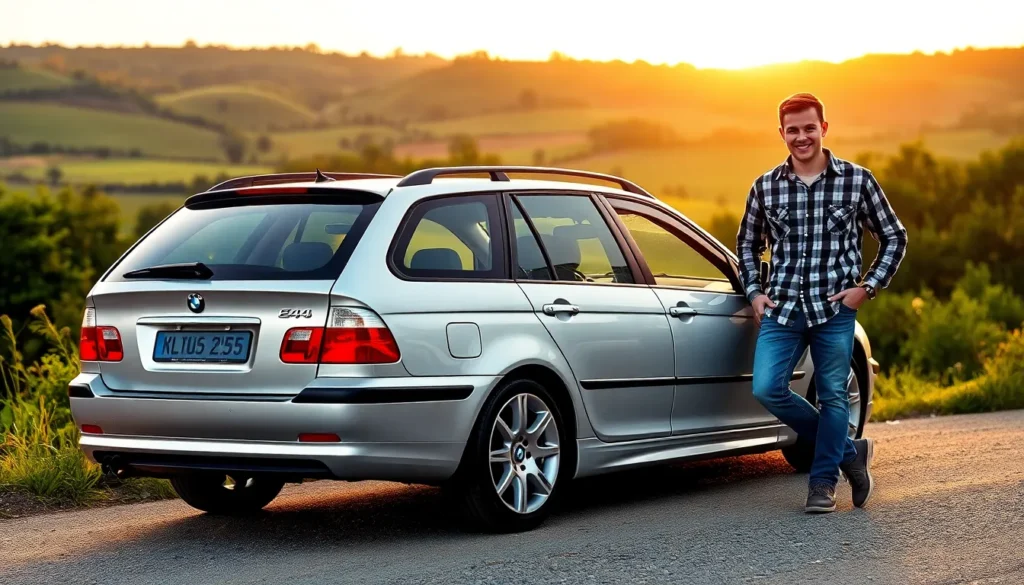The BMW E46 Touring stands as one of the most beloved wagons ever produced by the Bavarian automaker. We’ve witnessed countless enthusiasts fall head over heels for this practical yet sporty estate that perfectly balances daily usability with driving excitement. From its launch in 1999 to its final production year in 2005 the E46 Touring captured hearts with its sleek profile and impressive cargo capacity.
What makes this generation so special isn’t just its timeless design – it’s the way BMW managed to create a family hauler that doesn’t compromise on performance. We’ve seen these wagons tackle everything from grocery runs to track days with equal enthusiasm. Whether you’re considering buying one or already own this automotive gem you’ll discover why the E46 Touring has earned its place as a modern classic.
The combination of rear-wheel drive dynamics spacious interior and bulletproof reliability continues to attract drivers who refuse to choose between practicality and pure driving joy.
BMW E46 Touring Overview and History
BMW launched the E46 Touring in 1999 as the estate variant of its third-generation 3 Series lineup. Production continued through 2005 across BMW’s global manufacturing facilities, establishing the model as a cornerstone of the brand’s wagon offerings during the early 2000s.
Design Evolution and Platform
Built on BMW’s E46 platform, the Touring featured a stretched wheelbase measuring 2,725mm compared to the sedan’s standard dimensions. Engineers extended the rear overhang by 165mm to accommodate the enlarged cargo area, creating 435 liters of storage space with the rear seats upright. Folding the 60/40 split rear seats expanded capacity to 1,345 liters, making it one of the most practical vehicles in BMW’s lineup.
The Touring shared its front end styling with the E46 sedan and coupe models, maintaining the characteristic kidney grilles and quad headlight configuration. Distinctive rear pillar design and extended roofline set it apart from its siblings, while the tailgate featured BMW’s signature horizontal taillights integrated into the rear glass.
Engine Lineup and Performance Variants
BMW offered the E46 Touring with a comprehensive range of powertrains spanning from efficient four-cylinder units to high-performance inline-six engines. Entry-level 318i models featured a 1.9-liter four-cylinder producing 118 horsepower, while the 320i received a 2.0-liter unit generating 148 horsepower.
Six-cylinder variants included the 325i with its 2.5-liter M54 engine delivering 192 horsepower, and the range-topping 330i equipped with a 3.0-liter unit producing 228 horsepower. Diesel options comprised the 320d and 330d models, offering 148 and 202 horsepower respectively while delivering superior fuel economy.
Market Position and Global Availability
European markets received the widest selection of E46 Touring variants, including both manual and automatic transmission options across the engine range. North American customers had access to limited variants, primarily the 325xi and 330xi with BMW’s xDrive all-wheel-drive system.
Sales figures demonstrated strong European demand, with the Touring accounting for approximately 25% of total E46 production numbers. Germany remained the largest market, followed by the United Kingdom and other Western European countries where estate vehicles maintained popularity among families and business users.
Design and Exterior Features
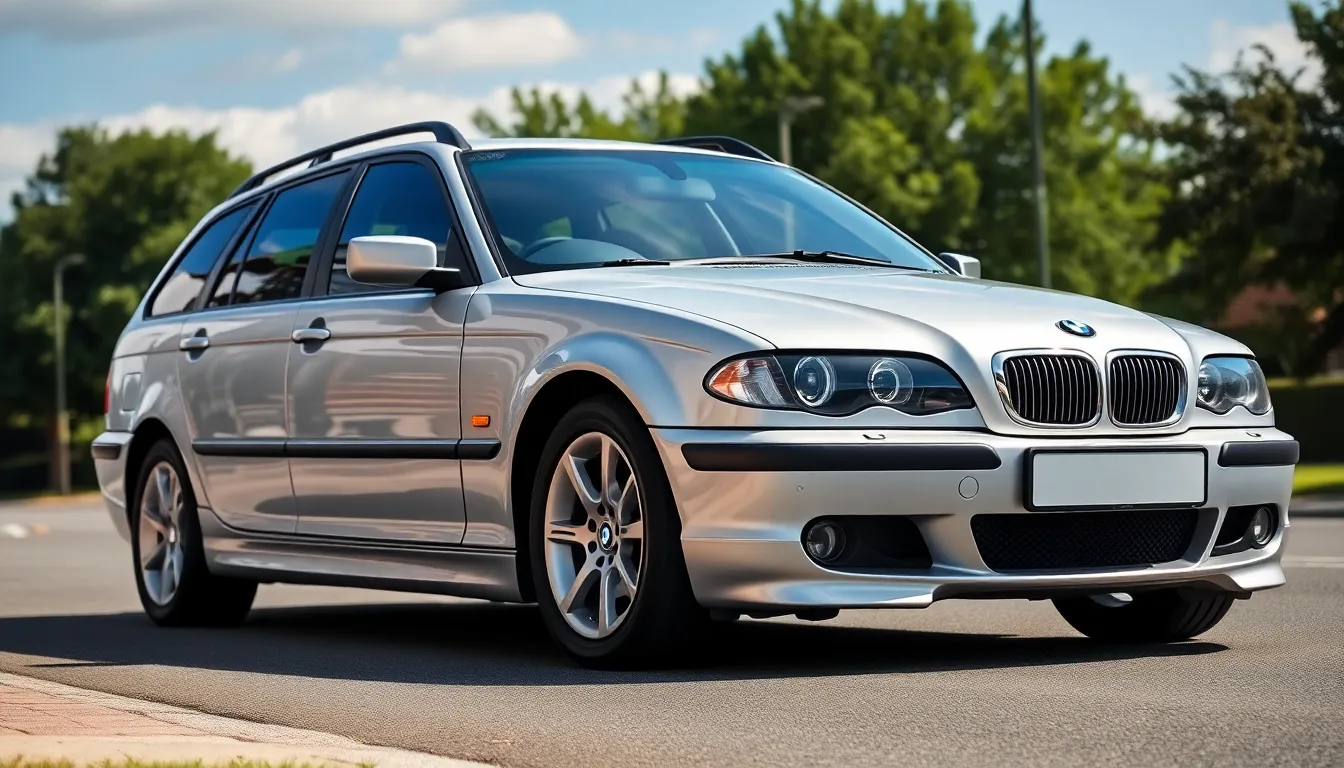
The BMW E46 Touring combines elegant estate proportions with the signature design language that defined the early 2000s BMW aesthetic. We find this wagon delivers a sophisticated appearance that balances functional cargo space with the sporty character expected from the 3 Series lineup.
Body Styling and Proportions
BMW engineers crafted the E46 Touring with a 110.6-inch wheelbase that extends 2.8 inches beyond the standard sedan configuration. The overall length measures 178.2 inches, providing optimal cargo integration without compromising the vehicle’s ever-changing visual stance. Sharp character lines flow from the front wheel arches toward the rear, creating a sense of forward motion even when stationary.
The front fascia mirrors the sedan and coupe variants, featuring BMW’s distinctive kidney grilles and angular headlight assemblies with optional xenon technology. Designers positioned the rear pillars at a steeper angle compared to traditional wagons, maintaining the sporting profile while maximizing interior headroom. Chrome window trim and body-colored door handles add premium touches that distinguish the Touring from entry-level competitors.
Roof rails come standard across all trim levels, integrating seamlessly with the overall design while providing practical mounting points for cargo carriers. The rear hatch incorporates a subtle spoiler lip that enhances aerodynamic efficiency and visual appeal. Side glass proportions create an airy cabin feel, with the rear quarter windows contributing to excellent visibility for both passengers and drivers.
Wheel Options and Stance
Factory wheel options range from 15-inch steel wheels on base models to 18-inch M Sport configurations on performance variants. The 16-inch Style 44 wheels became the most popular choice, featuring a five-spoke design that complements the E46’s clean styling language. Performance models like the 330i Touring often equipped 17-inch Style 68 wheels with wider tire profiles for enhanced grip and visual presence.
Suspension geometry maintains BMW’s signature rear-wheel-drive stance, with the front track measuring 58.7 inches and rear track at 59.1 inches. This setup creates a planted appearance that suggests the car’s ever-changing capabilities. Ground clearance sits at 5.3 inches, providing adequate protection for daily driving while keeping the center of gravity low for improved handling characteristics.
Aftermarket wheel fitments commonly range from 17×8 to 19×9.5 configurations, with popular offsets between ET35 and ET42 maintaining proper suspension geometry. Lowering springs typically reduce ride height by 1.0 to 1.5 inches, creating a more aggressive stance while preserving the practical ground clearance needed for cargo loading and daily usability.
Interior Space and Practicality
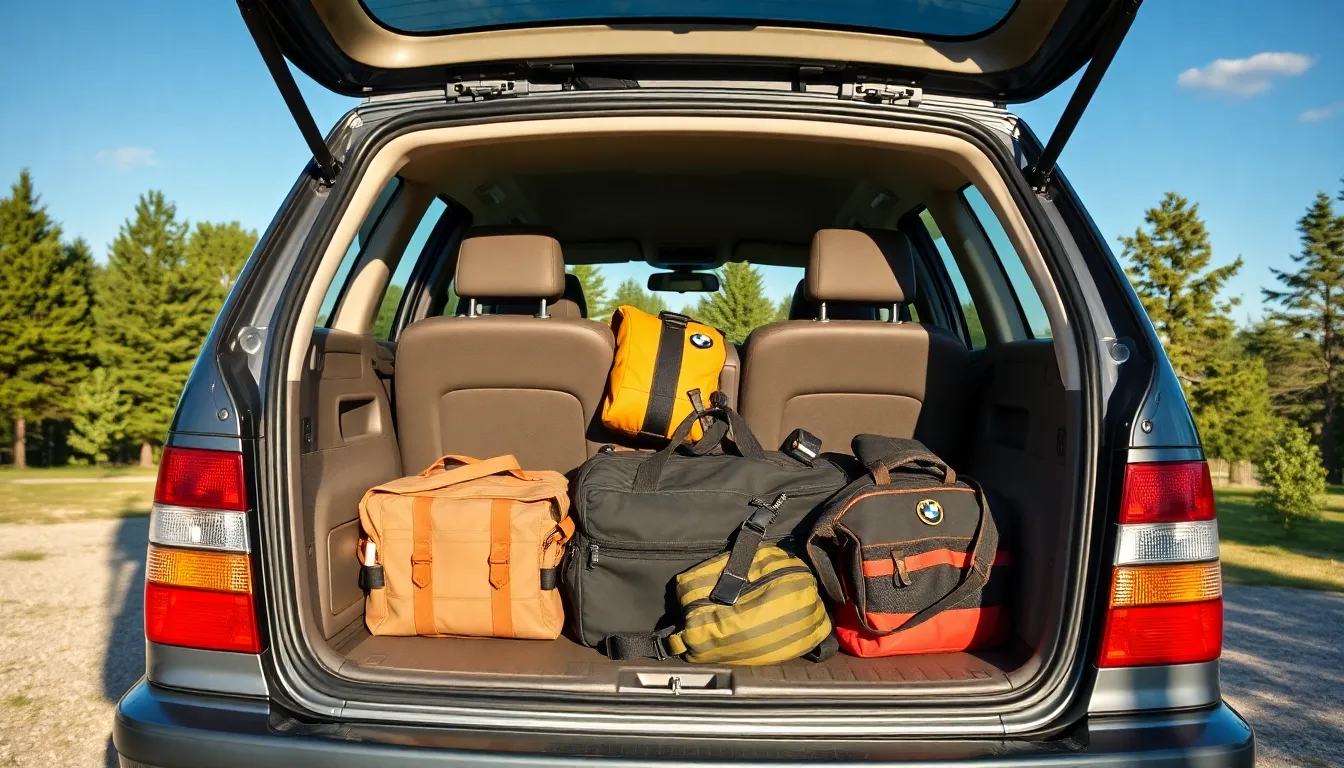
The E46 Touring maximizes interior utility through clever packaging that transforms BMW’s sport sedan platform into a genuinely practical family hauler. We find this wagon configuration delivers exceptional versatility for both passengers and cargo without compromising the driving dynamics that define the E46 generation.
Cargo Capacity and Storage Answers
Loading space measures 435 liters with rear seats upright, expanding to 1,345 liters when folded completely flat. The cargo floor sits at a convenient height of 28.7 inches from ground level, making heavy item loading more manageable compared to higher SUV configurations. We observe that the squared-off rear design maximizes usable volume within the overall footprint.
Storage compartments include multiple door pockets, center console bins, and a glove compartment that accommodates owner’s manuals plus small electronics. The rear cargo area features tie-down hooks at four corners and side storage nets for securing smaller items during transport. Floor rails allow for sliding cargo organizers that keep items from shifting during spirited driving sessions.
Under-floor storage provides space for the spare tire, tools, and emergency equipment without reducing main cargo capacity. The wide 42.5-inch rear opening accepts bulky items like furniture, sports equipment, and home improvement supplies that wouldn’t fit through conventional sedan trunks.
Rear Seat Configuration
Seating accommodates three passengers across the 60/40 split-folding rear bench, though two adults travel more comfortably for longer distances. Each section folds independently, allowing long items to pass through while maintaining one or two passenger positions. The release mechanisms operate from both the rear cargo area and the seat backs themselves.
Legroom measures 35.2 inches for rear passengers when front seats are positioned for average-height drivers. Headroom provides adequate clearance at 37.8 inches, though taller passengers might prefer the front positions. We note that the sloping roofline doesn’t significantly impact rear visibility or passenger comfort compared to the sedan variant.
Center armrest integration includes cupholders and small storage compartments accessible to rear passengers. The bench cushions offer firm support during cornering while maintaining comfort for extended highway travel. ISOFIX child seat mounting points are standard on both outer positions, making family transport more secure and convenient.
Engine Options and Performance
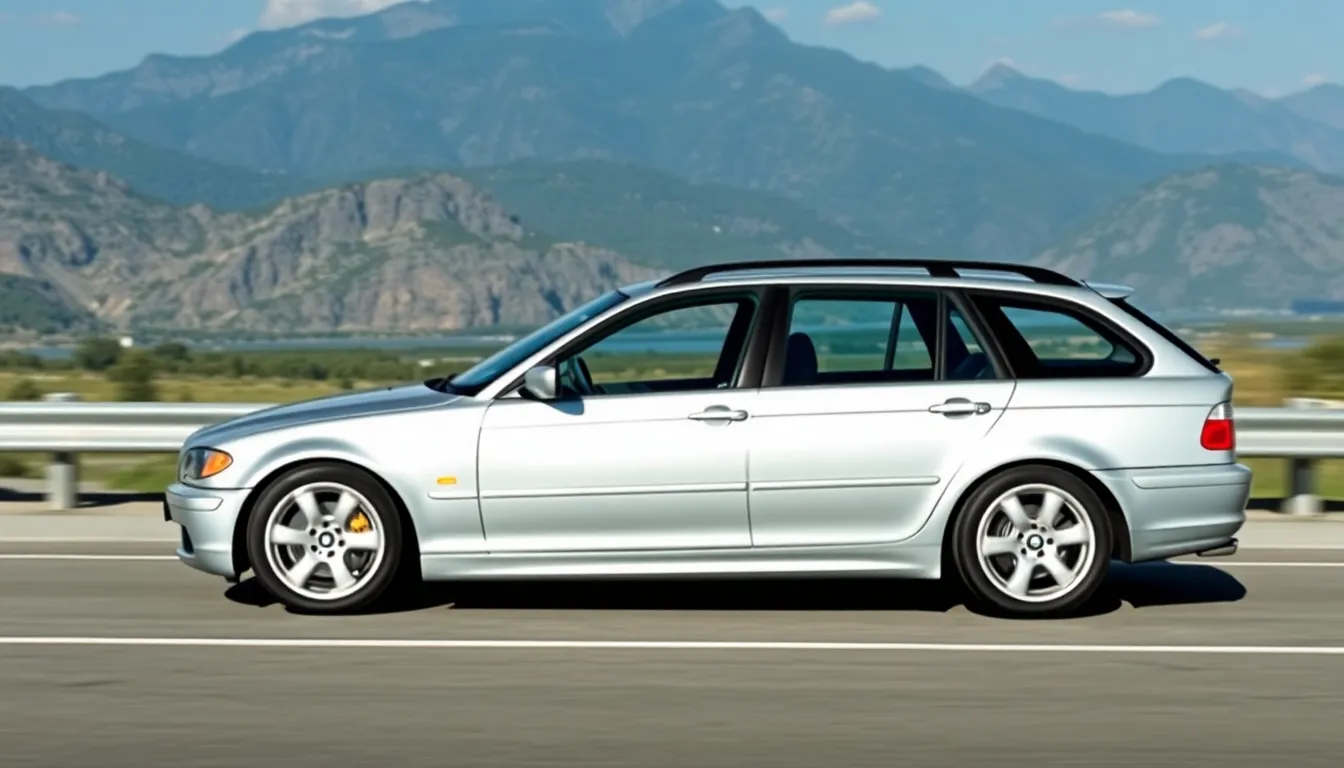
The BMW E46 Touring offers an extensive range of powertrains that cater to diverse driving preferences and performance requirements. Each engine configuration delivers distinct characteristics while maintaining the platform’s renowned balance of efficiency and driving dynamics.
Petrol Engine Lineup
BMW equipped the E46 Touring with five primary petrol engines spanning from economical four-cylinder units to high-performance inline-six powerplants. The base 318i features a 2.0-liter naturally aspirated four-cylinder engine producing 143 horsepower and 140 lb-ft of torque, delivering adequate performance for daily driving with fuel economy ratings of approximately 24 mpg combined.
Moving up the range, the 320i utilizes a 2.2-liter inline-six engine generating 170 horsepower and 152 lb-ft of torque. This configuration provides smoother power delivery compared to the four-cylinder variants while maintaining reasonable fuel consumption at 22 mpg combined.
The 325i represents a important step in performance with its 2.5-liter inline-six producing 192 horsepower and 181 lb-ft of torque. Acceleration improves notably with this engine, achieving 0-60 mph times of approximately 7.8 seconds while returning 21 mpg in combined driving.
At the top of the naturally aspirated lineup sits the 330i, featuring a 3.0-liter inline-six that generates 231 horsepower and 200 lb-ft of torque. Performance enthusiasts gravitate toward this variant for its 6.6-second 0-60 mph capability and smooth power band that extends to 6,500 rpm.
The range-topping 330i also serves as the foundation for the M54B30 engine, which incorporates BMW’s VANOS variable valve timing system and aluminum construction. This powerplant delivers linear acceleration and maintains strong mid-range torque delivery between 2,500-4,500 rpm.
Diesel Engine Variants
Diesel options in the E46 Touring lineup focus on fuel efficiency while providing adequate performance for European markets. The 320d features a 2.0-liter turbocharged four-cylinder diesel producing 150 horsepower and 221 lb-ft of torque, achieving remarkable fuel economy figures of 35 mpg combined.
Torque delivery in the 320d peaks at just 1,750 rpm, providing strong low-end pulling power ideal for highway cruising and cargo hauling. The engine utilizes common rail fuel injection technology and generates minimal noise intrusion into the cabin compared to earlier diesel designs.
The 330d represents the performance diesel option with a 3.0-liter turbocharged inline-six producing 204 horsepower and 302 lb-ft of torque. This configuration achieves 0-60 mph acceleration in 7.1 seconds while maintaining fuel economy ratings of 30 mpg combined, making it particularly attractive for long-distance touring applications.
Both diesel variants feature BMW’s advanced fuel injection systems and turbocharging technology that minimize lag while maximizing efficiency. The 330d’s inline-six configuration provides smoother operation and reduced vibration compared to four-cylinder diesel alternatives available in competing vehicles.
Transmission Choices
Manual transmission options dominate the E46 Touring lineup with BMW’s Getrag five-speed and six-speed units providing direct gear engagement and optimal power transfer. The five-speed manual appears in base models like the 318i and 320i, offering close gear ratios and a mechanical shift feel that enthusiasts appreciate.
Six-speed manual transmissions equip higher-performance variants including the 325i and 330i models. These units feature closer gear spacing and improved synchronization for quicker shifts, with gear ratios optimized for both acceleration and highway cruising efficiency.
Automatic transmission availability varies by engine configuration, with BMW’s five-speed Steptronic unit serving as the primary automatic option. The Steptronic system provides manual shift control through steering wheel paddles or gear lever positions while maintaining smooth operation in automatic mode.
All-wheel drive models designated with the “xi” suffix receive BMW’s xDrive system paired exclusively with automatic transmissions. The system distributes power between front and rear axles based on traction conditions, with a default 38/62 front-to-rear torque split under normal driving conditions.
Transmission ratios across the lineup optimize each engine’s power band characteristics. The 330i’s six-speed manual features a final drive ratio of 3.07:1, balancing acceleration performance with fuel economy during highway operation.
Driving Experience and Handling
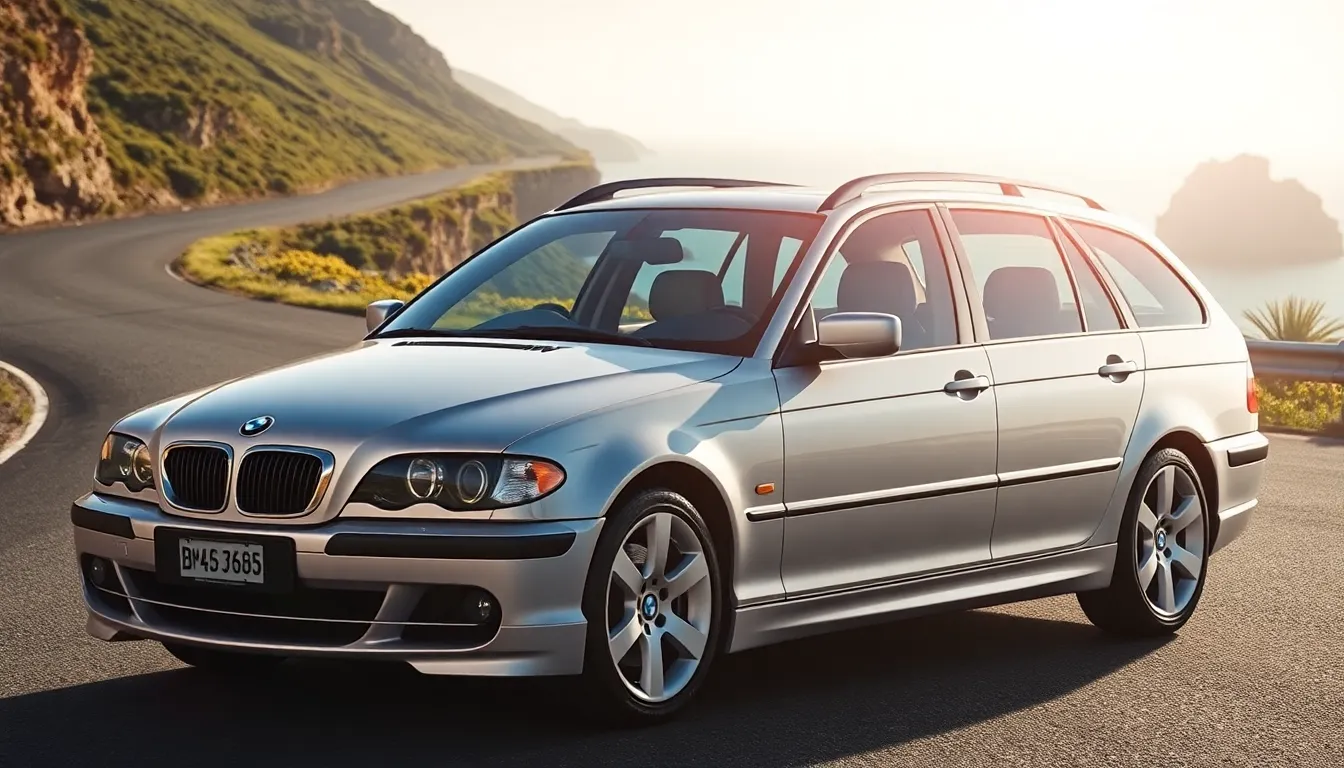
The E46 Touring delivers the quintessential BMW driving experience that enthusiasts expect from the brand’s sport wagons. Balance between practicality and performance defines every aspect of this vehicle’s ever-changing capabilities.
Road Manners and Comfort
Daily driving in the E46 Touring feels refined and composed across various road surfaces. Suspension tuning provides excellent body control while maintaining passenger comfort during highway cruising. Road noise levels remain minimal thanks to effective sound dampening materials throughout the cabin.
Steering feedback communicates road conditions precisely without becoming harsh or overly heavy during parking maneuvers. Power steering assistance varies appropriately with vehicle speed, offering light effort at low speeds and increased resistance during spirited driving. Weight distribution of 52/48 front to rear creates neutral handling characteristics that inspire confidence in wet weather conditions.
Braking performance demonstrates consistent pedal feel with minimal fade during extended use. Four wheel disc brakes provide adequate stopping power for the vehicle’s 3,300 to 3,500 pound weight range depending on engine configuration. Anti-lock braking system (ABS) and electronic brake distribution come standard across all trim levels.
Ride quality adapts well to different driving scenarios, absorbing minor road imperfections while maintaining sporty characteristics. Spring rates balance comfort with handling precision, creating a setup that works equally well for family transportation and weekend driving enjoyment.
Sporty Characteristics
Performance capabilities of the E46 Touring match those of its sedan counterparts across the engine range. Rear wheel drive architecture provides the captivating dynamics that BMW drivers value most. Weight distribution remains nearly identical to the sedan even though the extended cargo area and reinforced rear structure.
Cornering abilities showcase the benefits of BMW’s suspension geometry and chassis tuning expertise. Turn in response feels immediate and predictable, with minimal body roll even during aggressive direction changes. Electronic stability control (available on later models) enhances safety without compromising the natural driving feel.
Acceleration varies significantly between engine options, with the 330i achieving 0-60 mph times of 6.6 seconds while the 318i requires approximately 10.2 seconds for the same sprint. Torque delivery across the rev range provides strong mid-range performance that suits both city driving and highway passing situations.
Track capabilities exceed expectations for a wagon, with many owners participating in autocross and track day events successfully. Cooling systems handle extended performance driving well, and the lower center of gravity compared to SUVs contributes to stable handling characteristics at higher speeds.
Reliability and Common Issues

The BMW E46 Touring maintains the platform’s generally solid reliability record while presenting exact maintenance challenges that owners encounter. Understanding these issues helps potential buyers make informed decisions and current owners prepare for proactive maintenance.
Known Problem Areas
Window regulator failures affect most E46 Touring models after 80,000 miles, with rear windows experiencing more frequent breakdowns due to the wagon’s unique door mechanisms. Replacing these components costs $200-400 per window when using quality aftermarket parts.
Cooling system components deteriorate predictably in these vehicles, particularly the expansion tank and radiator around the 100,000-mile mark. The plastic expansion tanks develop stress fractures that lead to coolant leaks, while the aluminum radiators experience end tank separation. Complete cooling system overhauls typically run $800-1,200 using OEM parts.
VANOS (Variable Valve Timing) system issues appear in six-cylinder engines between 120,000-150,000 miles, causing rough idle and reduced power output. The VANOS seals harden over time, requiring replacement at approximately $600-900 for parts and labor.
Rear subframe mounting points show stress cracking in higher-mileage examples, particularly those driven aggressively or in harsh climates. This structural issue affects handling and safety, with repair costs ranging from $1,500-3,000 depending on the extent of damage.
Control arm bushings wear every 80,000-100,000 miles in typical driving conditions, creating steering vibration and uneven tire wear. Complete front control arm replacement with quality bushings costs $800-1,200 per side.
Maintenance Considerations
Oil change intervals require strict adherence to 7,500-mile schedules using BMW-approved synthetic oil to prevent premature engine wear. The inline-six engines particularly benefit from consistent oil maintenance, as the VANOS system depends on proper oil pressure and cleanliness.
Transmission service intervals occur every 60,000 miles for automatic transmissions and 100,000 miles for manual units, even though BMW’s original “lifetime fill” claims. Fresh transmission fluid prevents costly internal damage and maintains smooth operation.
Brake system maintenance becomes critical due to the E46 Touring’s additional weight compared to sedan variants. Brake fluid changes every two years prevent moisture buildup that causes brake fade and component corrosion.
Suspension components require inspection every 40,000 miles, as the wagon’s cargo capacity places additional stress on springs and shock absorbers. Performance-oriented drivers often upgrade to aftermarket suspension systems for improved handling and longevity.
Electrical system diagnostics benefit from regular battery and alternator testing, as the E46 platform’s many electronic modules strain aging charging systems. Preventive replacement of the battery every 5-6 years avoids starting issues and protects sensitive electronics.
Market Value and Buying Guide
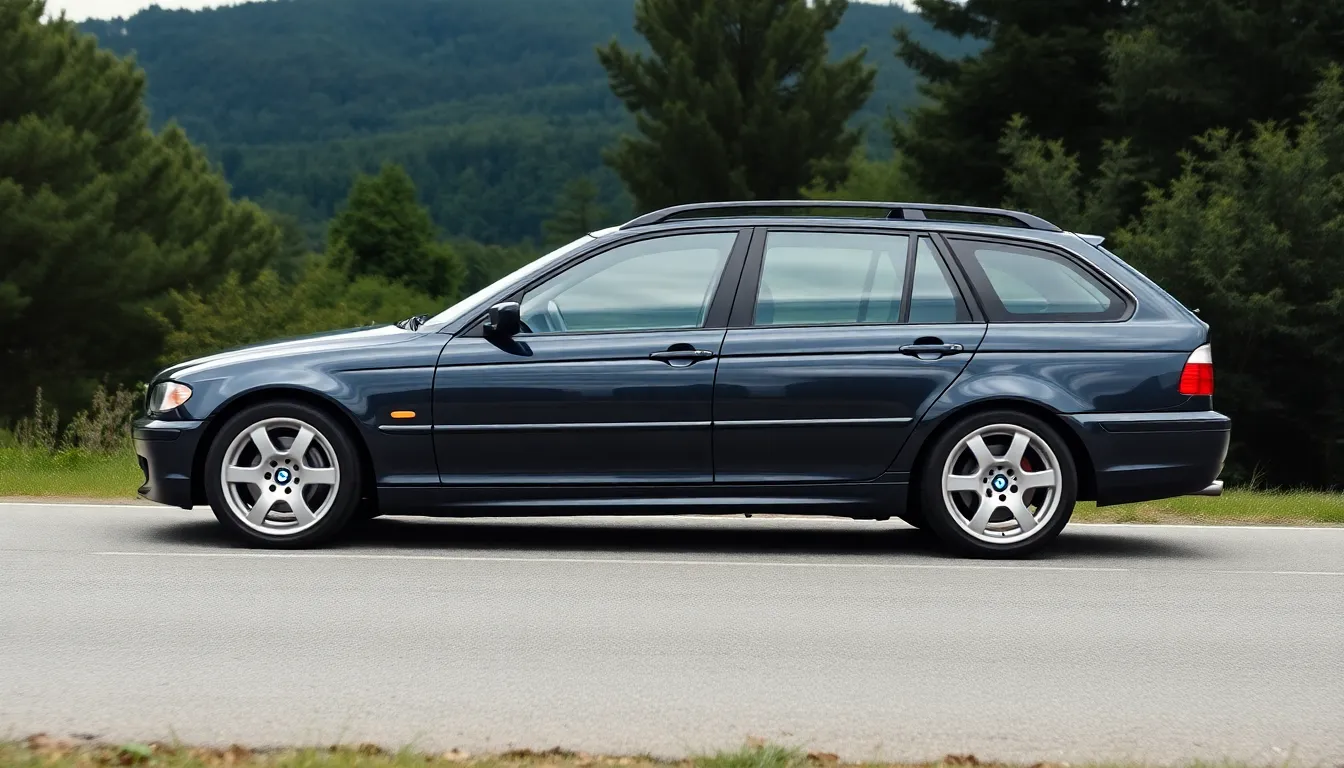
BMW E46 Touring values continue evolving as enthusiasts recognize these wagons as appreciating classics. Market demand strengthens each year for well-maintained examples.
Current Pricing Trends
E46 Touring prices vary significantly based on mileage, condition, and engine configuration across different regional markets.
| Model Variant | Mileage Range | Condition | Average Price Range |
|---|---|---|---|
| 318i Touring | 100k-150k miles | Good | $8,000-$12,000 |
| 320i Touring | 80k-120k miles | Excellent | $12,000-$18,000 |
| 325i Touring | 75k-100k miles | Good | $15,000-$22,000 |
| 330i Touring | 60k-90k miles | Excellent | $18,000-$28,000 |
Lower mileage examples with complete maintenance records command premium pricing in today’s collector market. European specification models often carry higher values than their US counterparts due to availability of additional engine options and features.
Diesel variants like the 320d and 330d maintain strong resale values in European markets where fuel efficiency remains prioritized. Six-cylinder models appreciate faster than four-cylinder variants as enthusiasts seek the characteristic inline-six sound and performance.
Geographic location affects pricing substantially with California and Northeast markets showing higher average values. Rust-free Southern examples trade at premiums over vehicles from snow belt regions where road salt accelerates corrosion.
What to Look for When Purchasing
Inspection priorities focus on the E46 Touring’s known problem areas and structural integrity points we’ve discussed throughout this article.
Cooling System Components
- Examine plastic radiator end tanks for stress cracks
- Test thermostat housing for leaks
- Verify water pump operation without noise or play
- Check expansion tank for hairline fractures
Window Regulators and Door Functions
- Operate all windows multiple times checking for grinding noises
- Verify smooth operation without hesitation or binding
- Test window auto-up and auto-down functions on equipped models
Subframe Mount Points
- Inspect rear subframe bushings for cracking or deterioration
- Look for stress fractures around mounting bolt locations
- Check alignment of rear suspension components
VANOS System Operation
- Listen for rattling noises during cold start on six-cylinder engines
- Verify smooth idle and proper timing advance
- Request maintenance records showing VANOS solenoid replacement
Interior and Cargo Area Condition
- Test rear seat folding mechanisms for proper operation
- Check cargo area floor for water damage or rust
- Verify all electrical functions including climate control and radio
Documentation proves crucial when evaluating any E46 Touring purchase. Complete service records demonstrate proper maintenance intervals and help identify potential future issues. Original window stickers and owner’s manuals add value for enthusiasts seeking authentic examples.
Paint condition affects long-term value significantly with original factory finish preferred over respray work. BMW’s clear coat from this era shows susceptibility to UV damage requiring careful inspection under various lighting conditions.
Conclusion
The BMW E46 Touring stands as a testament to German engineering excellence where practicality meets performance. We’ve explored how this wagon delivers the driving dynamics enthusiasts crave while offering the versatility modern families demand.
Whether you’re considering your first E46 Touring or you’re already part of the community we believe this platform represents one of BMW’s finest achievements. The combination of rear-wheel-drive handling timeless design and practical cargo space creates a unique ownership experience that’s increasingly rare in today’s automotive industry.
As values continue to appreciate we’re confident the E46 Touring will remain a sought-after classic that delivers both emotional satisfaction and smart investment potential for years to come.
Frequently Asked Questions
What years was the BMW E46 Touring produced?
The BMW E46 Touring was produced from 1999 to 2005 as the wagon variant of the third-generation 3 Series lineup. It was built on the E46 platform with a stretched wheelbase and enlarged cargo area to maximize practicality while maintaining the sporty characteristics BMW is known for.
How much cargo space does the E46 Touring offer?
The E46 Touring provides 435 liters of cargo space with the rear seats upright. When the 60/40 split-folding rear bench is folded down, the cargo capacity expands to 1,345 liters, making it highly versatile for both daily errands and larger hauling needs.
What engine options are available in the E46 Touring?
The E46 Touring offers a comprehensive range of engines including four-cylinder and inline-six petrol options like the 318i, 320i, 325i, and 330i. Diesel variants are also available for superior fuel economy. The powertrains range from efficient daily drivers to high-performance units catering to various driving preferences.
How fast is the BMW E46 330i Touring?
The BMW E46 330i Touring can accelerate from 0-60 mph in 6.6 seconds, matching the performance capabilities of its sedan counterpart. The rear-wheel-drive architecture and well-tuned suspension provide confident handling and cornering abilities suitable for both daily driving and spirited performance.
What are common reliability issues with the E46 Touring?
Common issues include window regulator failures, cooling system component deterioration, VANOS system problems in six-cylinder engines, and stress cracking in rear subframe mounting points. Regular maintenance including proper oil change intervals and cooling system service can help prevent many of these problems.
What should I look for when buying an E46 Touring?
Focus on known problem areas like cooling system components, window regulators, subframe mount points, and the VANOS system. Ensure thorough inspection and complete service records. Original paint condition and proper documentation significantly impact resale value, so verify maintenance history and overall condition carefully.
Are E46 Touring values appreciating?
Yes, E46 Touring values are evolving as enthusiasts recognize these wagons as appreciating classics. Current pricing varies significantly based on mileage, condition, and engine configuration, with lower mileage examples commanding premium prices. Geographic location also significantly affects pricing in the current market.
Is the E46 Touring good for track days?
Absolutely. The E46 Touring maintains the same sporty characteristics as its sedan counterparts, with many owners successfully participating in autocross and track day events. The rear-wheel-drive architecture, precise steering feedback, and well-balanced suspension make it capable on track while retaining everyday practicality.

